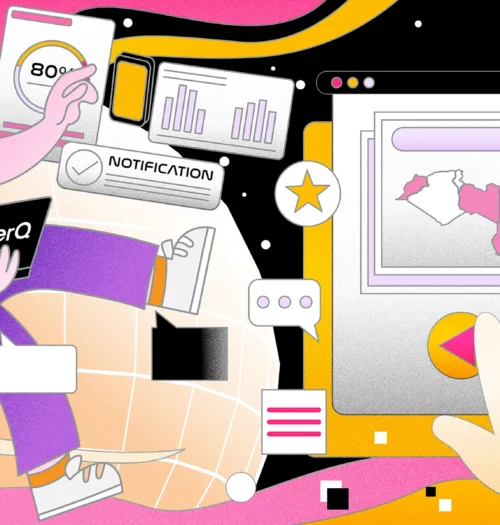🎁 Free 30-day publishing fees on Pay-As-You-GO. Get 15% off when recruiting from the UserQ Panel, with code HELLO15

User experience (UX) design is critical in shaping the end-user’s interaction with digital solutions. As it plays a vital role in a product’s success, you cannot afford to make mistakes in the UX design.
Bad user experience is frustrating, and it deters end-users from coming back, which can damage your reputation and hinder business growth. On the other hand, good UX ensures users can easily get the job done and cruise through the solution without any hiccups.
Good for you; it’s easier to differentiate between good and bad user experience. Here are 10 signs that indicate your product has a bad UX design.
10 Signs of a bad user experience design
User experience is affected when you create designs without understanding your target audience and considering their preferences. It can happen from an oversight or failure to create an ideal customer profile (ICP).
94 out of 100 times, users will look at the website’s design before interacting with it further. This goes on to cement the importance of having a good design, which leads to a good user experience. So, instead of knowing what works in terms of a good UX, let’s focus on what does not work.
1. The conversion rate on your website is low
Conversion happens when the users complete the action they were meant to complete using your digital product. It can be anything from subscribing to your newsletter, booking a demo, or purchasing.
A lower conversion rate implies that users couldn’t find the resources they needed to complete the tasks or weren’t convinced by what you were offering. Mostly, it’s the former.
For instance, a wrong “Buy” button on eCommerce websites can also affect UX. Wrong can be anything from strange placements to eye-pinching colors, to unreadable fonts, etc. Studies find that changing the “Buy” button’s color on eCommerce websites can improve conversions by 34%.
How to fix this?
Test your digital product for usability issues before its release. This will help you identify issues hindering user experience, either through wrong layout, placement of buttons, etc. For a detailed analysis, choose prototype testing, where you can assess whether your product meets the user’s expectations.
2. People are adding things to the cart and leaving
Cart abandonment is when users add products to the cart but do not proceed with the payments and purchases. This can be due to several reasons, but one of them is they are facing problems with checkout.
This implies that either your checkout process is complex, causing frustration, or it doesn’t have the preferred options like payments, delivery, etc. This implies revisiting the overall product strategy. Simplify the checkout process, offer clearer instructions, and refine other aspects of the user journey to enhance their experience and reduce cart abandonment.

Baymard Institute finds that 17% of customers abandon carts because the checkout process is too long or complex.
How to fix this?
Use session recordings to track your user’s actions and how they navigate through the website to analyze specific areas. Combine session recordings with heatmap analysis to pinpoint the areas of frustration for the customers. Fix these issues to prevent users from abandoning carts.
While reviewing the steps and repetitions you are asking your customers to complete before making a purchase. Simplify the process by either letting them save purchase information and add an auto-fill option to help customers speed up the process.
3. A lot of users are exiting quickly after coming to your page
Bounce rate is when users land on a website and exit quickly, mostly within seconds. The reason for bouncing off may be anything from a bad user experience, brand perception, unintuitive user interface, etc. In essence, whatever is above the fold line mostly determines whether the visitor will scroll down or not.
To ensure your visitors scroll down after first impression, take our 5-Second test to know what stands out on your website and what elements can deter your users from coming back.
If users don’t find value in what you offer or didn’t find the touchpoints on the website appealing, or they didn’t like the functionality, it prompts them to find value from another source, a competitor’s website, maybe.
A high bounce rate means users are spending very little time on the application or website.
How to fix this?
Bounce rate is individualistic to a page on a website, so the first step is to shortlist pages with high bounce rates. Once identified, use quantitative analytics like active sessions, session duration, recurring visitors to pinpoint the areas of concern.
Next run prototype tests and usability testing to detect issues in user flows and interactions that are causing high bounce rates. Using a mixed research analysis combining qualitative and quantitative methods, you will get two data sets on similar questions authenticating your research and analytics.
4. Users are not engaging with the page elements
Low engagement is the first sign of bad user interface design. From colors to typography to the visuals you have added to the digital solution, everything is required to build a good user interface. However, your users want designs that not only look good but also work equally well.
Indicators of low engagement are users not clicking links, buttons, forms, etc. Their lack of activity is a warning sign that the website has a cluttered and confusing layout, an unattractive and non-responsive design. It can also arise from slow page load times, lack of compelling content, and even poor CTAs.
It may also happen that the page has a high click-through rate (CTR), which means the source link is good, but once on the page, the users aren’t able to find what they are looking for, in which case, the page architecture needs to be revamped.
How to fix this?
User research is the only way to discover why users aren’t interacting with your product. Qualitative research like in-depth interviews, UX surveys, and focus groups are ideal methods to get good feedback on your product from the target audience.
5. The customer acquisition cost (CAC) is higher
32% of customers will stop interacting with a brand after one bad experience. When brands continuously have to spend more money on acquiring a customer than the revenue they expect to generate from them, it shows customers aren’t interested in engaging with your product.

High acquisition costs can stem from several reasons, including;
- High bounce rate due to poor and cluttered website design which makes navigating through the website difficult and visitors leave before converting, driving up the acquisition costs.
- Slow loading websites make users leave without interacting, which increases the cost of driving traffic to the website.
- When a website’s design, offerings, and a user’s expectations don’t match they feel disconnected and abandon the site.
Moreover, it’s not always about the digital experience, but elements like customer support, shipping, product quality can also drive away potential customers. Similar elements applicable to eCommerce stores include limited payment options, a complicated checkout process, lack of clear return policies, and unclear shipping information. All of these means you have to spend more money on bringing potential leads to the website.
How to fix this?
First, find the reason behind your users leaving without making a purchase. The reason can be anything from a lack of personalization, product price, or bad interface design. Address the potential leaks in the conversion funnel, which takes users from signing up to making a purchase. Find where they abandon during the journey and fix the gap.
6. Users spend a lot of time searching for what they need
Excessive and repetitive searches on the website indicate a lack of intuitive navigation, search functionality, or an unclear information architecture. Where your users expect to find the information they need quickly, poor search functionality or menu structure can hamper their experience.
Repeatedly searching for one thing also causes cognitive overload, decreasing trust in the product. Not only will you lose their faith, but you also lose your prospects as they switch to competitors.
How to fix this?
Users spending excessive time on your website looking for something also indicates a bad user experience, especially when combined with long search log files. Create a new navigation with card sorting to assess how you can best categorize information on the website. Combine it with tree testing identify the optimal structure and set the optimal hierarchy on the website. Building the navigation through these tests ensures your users can quickly find the information they need without excessive clicks and searches.
In addition to improving search functionality, include a sitemap in the footer section ensuring your users can browse through the website menus without being confused.
7. Your customer support is always busy pacifying customers
When your customers are knocking on the customer support team’s door to file complaints or get help more than usual, chances are they are facing issues in finding information, making a purchase, device inconsistencies, lack of mobile responsiveness, or an overcomplicated process.
Take note of the customer complaints, especially the ones which affect user experience.
How to fix this?
Since the issues hurting user experience can vary from customer to customer, run a thematic analysis to find common themes. Use this method to pinpoint the specific problem and correct them.
Using the analysis, curate bespoke strategies to counter each point and create a priority list to fix the issues that can hurt customer experience the most. Also maintain a customer feedback loop where you inform your customers about how you are fixing the issues they are facing.
8. You are getting a lot of bad reviews
When customers are bad-mouthing you on the internet, sending emails, or talking to customer support, they are not happy. Assess their reviews to identify the issues separately and determine the best solution for customer problems.
For instance, when an eCommerce website gets frequent complaints about the page navigation or checkout process or limited payment options, this directly affects brand reputation. Moreover, people reading these reviews will also refrain from using your product.
How to fix this?
Integrate NPS survey or customer satisfaction score (CSAT) within your website and trigger it at regular intervals to give the opportunity to your customers to share what they are facing.
Giving them the opportunity to share their concerns while they are facing them ensures you get first-hand information, which helps with making changes before a single bad experience prompts the users to rant it out among their circle.
9. Users don’t return after the first interaction
Low user retention signifies that the first experience isn’t worth remembering, which makes your prospects unwilling to return for another engagement. It’s simple: if users liked their engagement with your product, wouldn’t they come back for more?
And if they aren’t coming back, they don’t like what you are offering. However, finding the reason behind the low retention rate is critical.
How to fix this?
If users are not returning, it may be because your product’s value doesn’t resonate with them. Reassess whether your product is solving the user’s problem and whether it’s distinct from what your competitors are offering.
You must also conduct a detailed target audience analysis to ensure you are approaching the right prospects. Find the gaps and fix them.
10. When changes to the design have little to no effect
Regularly making changes is an important part of product-led engagement strategy, but when these changes aren’t bringing a better response, you are doing something wrong. And designers and UX experts often build products with tunnel vision, which only makes them human.
How to fix this?
Building and improving your products with understanding your customers first is a great way to make products that they will like. Integrate user testing in your product development cycle to build user-centric products.
To sum it up
Optimizing the product design and functionality is the first step to prevent a bad user experience. From intuitive navigation to customer-centric design and all the essential features, a lot goes into ensuring your customers aren’t abandoning your product for another.
At UserQ, we offer 7 testing methodologies, including tree tests, prototype testing, card sorting, survey, etc. to help you assess your digital products. Our tests are curated specifically for Middle East companies allowing you to run user tests in English and Arabic either by using your own audience or our testers panel. As every customer interaction matters, we ensure you deliver the best possible solution to your customers.
Get started with our services or book a demo to know how we can help you build better products.
Related Post

Potential of AI in UX
With companies prioritising user-centric design to satisfy customer expectations, the Middle East and North Africa (MENA) area is a fast

Tips to write effective prototype
Success in prototype testing can take many forms. For some, successful testing is when they receive authentic and actionable feedback,

User research recruitment in the
User research is an essential part of creating products that genuinely meet user needs, ensuring that the final design is
Subscribe to our
product newsletter!
Receive emails about UserQ updates, new features,
offers and latest trends.


